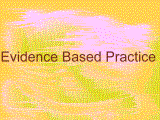| This course generally |
| About this module |
| Preparation prior to the module |
| Effective search for evidence |
| Assessment |
| Reading list |
| News |
| Online queries or comments |
| Useful tools |
| Glossary of EBP terms (Alternative site) |
| Calculator |
| Useful links |
| Preparation before each session |
| Diagnosis |
| Search etc |
| Therapy and Harm (RCT) |
| Therapy & Harm (SR) |
| Prognosis |
| Guidelines |
| EBHC1 |
| EBHC2 |
| Implementation |
| Current and past students only information |
| Lecture notes |
| EBP calculator |
EBP calculator
2. Calculating ARR and NNT adjusted for a specific patient

3. Calculating NNT from Odds Ratio and baseline risk
Warning:- This calculation does not necessarily give you
the correct SIGN (i.e. whether positive i.e. NNT, or negative, i.e. NNH). You
have to decide the sign for yourself - which should be easy if you understand
the basic principles. For example, compare the results of
a) PEER = 0.5,
OR=2
b) PEER = 0.5, OR=0.5
and decide what the signs should
be.
If the above site is down, you can find appropriate information (but without online calculator) here.
4.
Calculating the 95% confidence interval of a SIMPLE
proportion
e.g. in prognosis (the proportion of patients who died
within a certain time); sensitivity and specificity. We covered this in the
prognosis session. Compare the result from this calculator with your
calculations using methods taught in the session.
N.B. This is NOT appropriate for calculating other measures such as ARR (i.e. difference between two proportions) or relative risk (i.e. the ratio of two proportions).
Updated reading
list
Assignment-related resources
Asynchronous Learning Network ALN Journal
Articles relating to the the role of asynchronous network in learning
Australian Journal of Educational Technology
Articles relating to the use of information technology in
learning.
Evidence-based nursing
For those with nursing background, this free online journal
contains many useful articles and reviews.
Examples of how EBP is used
The following brief reports from the BMJ illustrate how to give a case scenario, frame questions, document search strategy.
These reports also evaluate the evidence and applying it to the clinical scenario. However, these reports evaluate several studies but you are are asked to evaluate only ONE or TWO studies for your assignment. Also, these reports are very brief in the sections on evaluating validity and applicability but you need to give much more details.
Evidence based well child care
Evidence based management of childhood obesity
Evidence based management of seizures associated with fever
Evidence based management of nocturnal enuresis
Evidence based management of attention deficit hyperactivity disorder
This page is created and maintained
by Wai-Ching Leung
e-mail:-
wp102@yahoo.com
last modified January 2002
